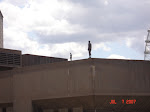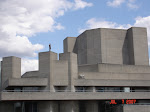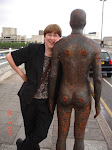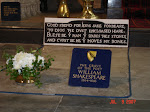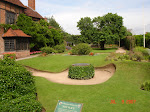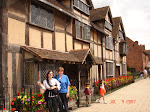
St. Paul's Cathedral
Sunday, July 8, 2007
Several members of the British Studies program joined throngs of other worshipers in attending morning services at St. Paul's Cathedral. As we came closer to the church, we could hear the celebration of the cathedral bells which echoed the joy that I felt at actually being in London for the first time.
Several members of the British Studies program joined throngs of other worshipers in attending morning services at St. Paul's Cathedral. As we came closer to the church, we could hear the celebration of the cathedral bells which echoed the joy that I felt at actually being in London for the first time.
Thursday, July 12, 2007-British Library
On our tour of The British Library today, we discovered that over 2300 people are employed there, with an annual budget of about £12,000,000. Over 35 million items are stored at that location, with another 174 million items stored in three other locations. To contain the ever-growing collection, linear shelving space has to be increased by 8 miles or more per year. The numbers are quite astounding. The most astounding fact though, is that the books are not arranged in Dewey Decimal order, but rather by size, in that space is at a premium. Location numbers, which are stamped on book spines, are derived from a grid system detailing floor, shelf, row, quadrant, etc. Most library holdings are kept in closed stacks.
The British Library processes about a million user requests per year. In order to have items retreived for use, patrons who have gone through a screening process with library staff in the Reader Request department use an online catalog to locate items of interest, make a computerized request to see an item, and then two call slip cards are generated by the computer. A library worker goes to the stacks and retrieves the item, leaves one of the slips at the book's location on the shelf, sends the book to the retrieval room, where it is checked in on the ILS using a barcode scanner. The item is then sent to the particular reading room where it is being made available and the patron is instructed to use it there. The retrieval process is expected to take no more than 70 minutes if the item is housed on-site, and about 24 hours if housed off-site.
Our guide told us that the British Library has three functions; to build a national collection of all that is published in the United Kingdom, to keep each item forever (thus the appropriateness of the book and chain sculpture inside the entrance to the library); and finally, to make the items available to the public.
It took about 34 years for the library to be built after it was designed in 1963. The building is rather whimsically built in the shape of an ocean liner, and was designed for about 300 years of use. The British Library moved from its original location at the Montague House (the current location of the British Museum) and was opened in 1997, and officially dedicated by the queen in 1998. The facility is obviously heavily used, and it is both inviting and majestic. The library materials are made availabe free of charge, with the exception of some special collections, and is funded by public monies, as well as fees charged for various library services, including the sales of catalog records generated by British Libraries staff, which amounts to about £20,000,000.00 per year.
The library has quite a large staff, including catalogers, acquisitions workers, librarians who screen new users, book handlers who locate and replace books, information technologists, computer programmers who create and maintain the four different computerized systems used by the library, and many other library employees who are typical of any very large library, including archivists and conservationists. The British Library no doubt has a niche for every specializaton in the library and information science field.
The British Library processes about a million user requests per year. In order to have items retreived for use, patrons who have gone through a screening process with library staff in the Reader Request department use an online catalog to locate items of interest, make a computerized request to see an item, and then two call slip cards are generated by the computer. A library worker goes to the stacks and retrieves the item, leaves one of the slips at the book's location on the shelf, sends the book to the retrieval room, where it is checked in on the ILS using a barcode scanner. The item is then sent to the particular reading room where it is being made available and the patron is instructed to use it there. The retrieval process is expected to take no more than 70 minutes if the item is housed on-site, and about 24 hours if housed off-site.
Our guide told us that the British Library has three functions; to build a national collection of all that is published in the United Kingdom, to keep each item forever (thus the appropriateness of the book and chain sculpture inside the entrance to the library); and finally, to make the items available to the public.
It took about 34 years for the library to be built after it was designed in 1963. The building is rather whimsically built in the shape of an ocean liner, and was designed for about 300 years of use. The British Library moved from its original location at the Montague House (the current location of the British Museum) and was opened in 1997, and officially dedicated by the queen in 1998. The facility is obviously heavily used, and it is both inviting and majestic. The library materials are made availabe free of charge, with the exception of some special collections, and is funded by public monies, as well as fees charged for various library services, including the sales of catalog records generated by British Libraries staff, which amounts to about £20,000,000.00 per year.
The library has quite a large staff, including catalogers, acquisitions workers, librarians who screen new users, book handlers who locate and replace books, information technologists, computer programmers who create and maintain the four different computerized systems used by the library, and many other library employees who are typical of any very large library, including archivists and conservationists. The British Library no doubt has a niche for every specializaton in the library and information science field.
Subscribe to:
Comments (Atom)
